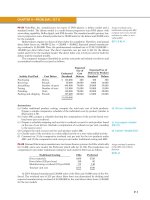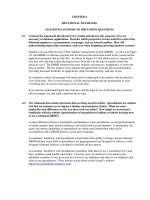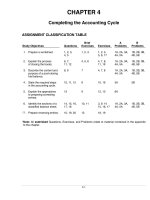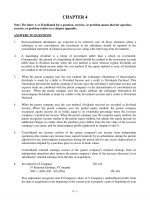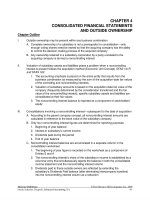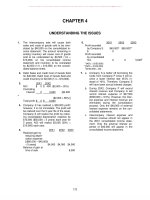Ch04 hullofod8 thedition
Bạn đang xem bản rút gọn của tài liệu. Xem và tải ngay bản đầy đủ của tài liệu tại đây (1014.7 KB, 40 trang )
Chapter 4
Interest Rates
Options, Futures, and Other Derivatives 8th Edition,
Copyright © John C. Hull 2012
1
Types of Rates
Treasury rates
LIBOR rates
Repo rates
Options, Futures, and Other Derivatives 8th Edition,
Copyright © John C. Hull 2012
2
Treasury Rates
Rates on instruments issued by a
government in its own currency
Options, Futures, and Other Derivatives 8th Edition,
Copyright © John C. Hull 2012
3
LIBOR and LIBID
LIBOR is the rate of interest at which a bank
is prepared to deposit money with another
bank. (The second bank must typically have
a AA rating)
LIBOR is compiled once a day by the British
Bankers Association on all major currencies
for maturities up to 12 months
LIBID is the rate which a AA bank is prepared
to pay on deposits from anther bank
Options, Futures, and Other Derivatives 8th Edition,
Copyright © John C. Hull 2012
4
Repo Rates
Repurchase agreement is an agreement
where a financial institution that owns
securities agrees to sell them today for X and
buy them bank in the future for a slightly
higher price, Y
The financial institution obtains a loan.
The rate of interest is calculated from the
difference between X and Y and is known as
the repo rate
Options, Futures, and Other Derivatives 8th Edition,
Copyright © John C. Hull 2012
5
The Risk-Free Rate
The short-term risk-free rate traditionally
used by derivatives practitioners is LIBOR
The Treasury rate is considered to be
artificially low for a number of reasons (See
Business Snapshot 4.1)
As will be explained in later chapters:
Eurodollar futures and swaps are used to extend
the LIBOR yield curve beyond one year
The overnight indexed swap rate is increasingly
being used instead of LIBOR as the risk-free rate
Options, Futures, and Other Derivatives 8th Edition,
Copyright © John C. Hull 2012
6
Measuring Interest Rates
The compounding frequency used for
an interest rate is the unit of
measurement
The difference between quarterly and
annual compounding is analogous to
the difference between miles and
kilometers
Options, Futures, and Other Derivatives 8th Edition,
Copyright © John C. Hull 2012
7
Impact of Compounding
When we compound m times per year at rate R an
amount A grows to A(1+R/m)m in one year
Compounding frequency
Value of $100 in one year at 10%
Annual (m=1)
110.00
Semiannual (m=2)
110.25
Quarterly (m=4)
110.38
Monthly (m=12)
110.47
Weekly (m=52)
110.51
Daily (m=365)
110.52
Options, Futures, and Other Derivatives 8th Edition,
Copyright © John C. Hull 2012
8
Continuous Compounding
(Page 79)
In the limit as we compound more and more
frequently we obtain continuously compounded
interest rates
$100 grows to $100eRT when invested at a
continuously compounded rate R for time T
$100 received at time T discounts to $100e-RT at
time zero when the continuously compounded
discount rate is R
Options, Futures, and Other Derivatives 8th Edition,
Copyright © John C. Hull 2012
9
Conversion Formulas (Page 79)
Define
Rc : continuously compounded rate
Rm: same rate with compounding m times per
year
Rm
Rc m ln 1
m
Rm m e Rc / m 1
Options, Futures, and Other Derivatives 8th Edition,
Copyright © John C. Hull 2012
10
Examples
10% with semiannual compounding is
equivalent to 2ln(1.05)=9.758% with
continuous compounding
8% with continuous compounding is
equivalent to 4(e0.08/4 -1)=8.08% with quarterly
compounding
Rates used in option pricing are nearly
always expressed with continuous
compounding
Options, Futures, and Other Derivatives 8th Edition,
Copyright © John C. Hull 2012
11
Zero Rates
A zero rate (or spot rate), for maturity T is the
rate of interest earned on an investment that
provides a payoff only at time T
Options, Futures, and Other Derivatives 8th Edition,
Copyright © John C. Hull 2012
12
Example (Table 4.2, page 81)
Maturity (years)
Zero rate (cont. comp.
0.5
5.0
1.0
5.8
1.5
6.4
2.0
6.8
Options, Futures, and Other Derivatives 8th Edition,
Copyright © John C. Hull 2012
13
Bond Pricing
To calculate the cash price of a bond we
discount each cash flow at the appropriate
zero rate
In our example, the theoretical price of a twoyear bond providing a 6% coupon
semiannually is
3e
0.050.5
3e
0.058 1.0
3e
0.064 1.5
103e 0.0682.0 98.39
Options, Futures, and Other Derivatives 8th Edition,
Copyright © John C. Hull 2012
14
Bond Yield
The bond yield is the discount rate that makes
the present value of the cash flows on the
bond equal to the market price of the bond
Suppose that the market price of the bond in
our example equals its theoretical price of
98.39
The bond yield (continuously compounded) is
given by solving
3e y 0.5 3e y 1.0 3e y 1.5 103e y 2.0 98.39
to get y=0.0676 or 6.76%.
Options, Futures, and Other Derivatives 8th Edition,
Copyright © John C. Hull 2012
15
Par Yield
The par yield for a certain maturity is the
coupon rate that causes the bond price to
equal its face value.
In our example we solve
c 0.050.5 c 0.0581.0 c 0.0641.5
e
e
e
2
2
2
c 0.0682.0
100 e
100
2
to get c=6.87 (with semiannual compoundin g)
Options, Futures, and Other Derivatives 8th Edition,
Copyright © John C. Hull 2012
16
Par Yield continued
In general if m is the number of coupon
payments per year, d is the present value of
$1 received at maturity and A is the present
value of an annuity of $1 on each coupon
date
(100 100 d ) m
c
A
(in our example, m = 2, d = 0.87284, and A =
3.70027)
Options, Futures, and Other Derivatives 8th Edition,
Copyright © John C. Hull 2012
17
Data to Determine Zero Curve
(Table 4.3, page 82)
Bond Principal
Time to
Maturity (yrs)
100
0.25
0
97.5
100
0.50
0
94.9
100
1.00
0
90.0
100
1.50
8
96.0
100
2.00
12
101.6
*
Coupon per
year ($)*
Bond price ($)
Half the stated coupon is paid each year
Options, Futures, and Other Derivatives 8th Edition,
Copyright © John C. Hull 2012
18
The Bootstrap Method
An amount 2.5 can be earned on 97.5 during
3 months.
Because 100=97.5e0.10127×0.25 the 3-month rate
is 10.127% with continuous compounding
Similarly the 6 month and 1 year rates are
10.469% and 10.536% with continuous
compounding
Options, Futures, and Other Derivatives 8th Edition,
Copyright © John C. Hull 2012
19
The Bootstrap Method continued
To calculate the 1.5 year rate we solve
4e 0.104690.5 4e 0.105361.0 104e R1.5 96
to get R = 0.10681 or 10.681%
Similarly the two-year rate is 10.808%
Options, Futures, and Other Derivatives 8th Edition,
Copyright © John C. Hull 2012
20

